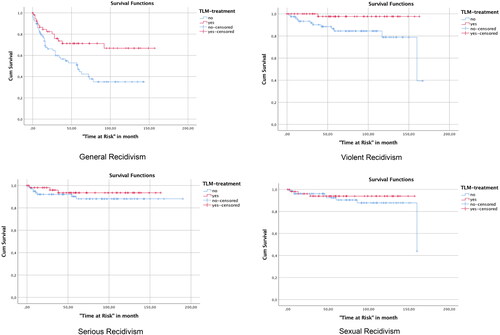Figures & data
Table 1. Differences between individuals with (+TLM; n = 54) and without (−TLM; n = 79) TLM-treatment.
Table 2. Index offence, kind of former imprisonment, treatment status at the FTA and diagnoses according to ICD-10 of the treatment group with (+TLM; n = 54) and without TLM (−TLM; n = 79).
Table 3. Recidivism rates of the treatment group with TLM (+TLM; n = 54) and without TLM (−TLM; n = 79).
Figure 1. Kaplan-Meier curves of the + TLM (n = 54) and the − TLM (n = 79) regarding different forms of recidivism.

Table 4. Cox-regression on the prediction of general recidivism with TLM- treatment as time-dependent covariate, controlled for Initial risk at the time of release measured by static-99R for the + TLM (n = 54) and the − TLM (n = 79).
Table 5. Differences between individuals who stopped TLM-treatment and recidivated (treatment withdrawal-recidivism, TWR; n = 13) and individuals who stopped TLM-treatment and did not recidivate (treatment withdrawal-no recidivism, TWnR; n = 6) TLM-treatment.
Data availability
The data that support the findings of this study are available from the corresponding author, JS, upon reasonable request. The data are not publicly available due to restrictions as their containing information that could compromise the privacy of research participants.
